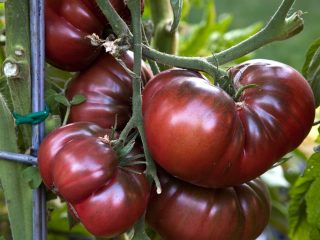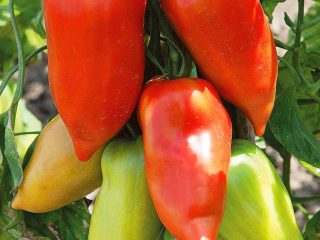Content
Gardeners looking for a reliable, time-tested variety should pay attention to the Pink Heart tomato. Large fruits are widely used for preparing a variety of dishes: salads, sauces, juices. Suitable for preservation and pickling. True, in order to reap a bountiful harvest, you will have to make some efforts.

Tomatoes are grown in regions with different climatic conditions
History of selection
The Pink Heart variety was bred by Russian breeders. In 2002, it was included in the register of vegetable crops and approved for use in open ground and greenhouses.
Description and characteristics of the tomato variety Pink Heart
Description of tomato Pink Heart:
- The bushes are tall, indeterminate type, with a height of 1.8 to 2 m.
- The stems are straight, strong and stable, but during the fruiting period they need to be tied to a trellis.
- The leaves are large, carved, and intensely green in color.
- The first tomatoes are large and heavy, weighing 400-500 g. Later, the fruits grow no more than 230 g. They are heart-shaped and slightly ribbed at the base.
- Ripe fruits are colored deep pink and covered with a thin skin, under which there is a fleshy and sugary pulp.

The fruits do not tolerate transportation well and are only suitable for home cultivation
Maturation period
Pink heart is characterized by mid-ripening. The period from sowing to full ripening of the fruit lasts approximately 115 days.
Pink Heart Tomato Productivity
According to official data, from one sq. meter you can get 6.1 kg of fruits of commercial quality. However, judging by reviews from gardeners, in colder regions yields are slightly lower.

It is possible to collect up to 3 kg of tomatoes from one bush
Disease resistance
Tomatoes of the Pink Heart variety are immune to fungal infections. At the same time, preventive measures must be carried out regularly. In addition, it is necessary to observe the watering and lighting regime. Then the bushes will remain healthy and strong throughout the season.
Growing regions
The variety is recommended for all regions of the Russian Federation. In the middle zone, tomatoes of this variety are grown in greenhouses or greenhouses, and in the northern regions - in heated rooms. Tomatoes that grow in open ground bear fruit earlier. But greenhouse plants are not damaged by pests.
Purpose and application
Tomatoes are used universally - eaten fresh, added to vegetable slices, marinated in slices with garlic and dill. A salted tomato appetizer is an integral part of the family meal.
Advantages and disadvantages
Farmers are not particularly fond of this variety, because the fruits, although not prone to cracking, do not tolerate transportation over long distances.

Tomato Pink Heart forms masses of ovaries on bushes, regardless of climatic conditions
Pros:
- tomatoes are ideal for preparing summer salads because they have moderate juiciness;
- bushes can be grown indoors and in open beds;
- tomato is resistant to harmful insects and infections, including leaf spot;
- The taste is dominated by sweetness and practically no sourness.
Minuses:
- tomatoes are deformed during transportation and cannot be stored for long periods of time;
- due to unlimited growth, the bushes must be pruned and pinched;
- the variety is characterized by average yield and is grown only for personal purposes.
- The tomato is demanding to care for and demanding of growing conditions.
Sowing seeds and planting in open ground
Tomato seeds are sown for seedlings in March. The containers are filled with loose, nutritious soil and grooves are formed. Seeds are sown in the holes made and sprinkled with a layer of peat on top. The boxes are placed on a sunny windowsill where the temperature is 25 °C. When the first shoots appear, they are transferred to a cooler room at 15 ° C and left for a week, and then put back in a warm place.

The influence of temperatures increases the endurance of future tomatoes
When 2-3 true leaves appear, the young plants are carefully transplanted into personal cups.
Tomatoes are transferred to open beds in May-June. The holes are formed at a distance of 40-50 cm from each other. A little ash and mineral fertilizers are placed at the bottom of each. Seedlings are planted vertically, covering the roots with soil to prevent voids from appearing. After planting, the plantings are watered and mulched abundantly.
Care instructions
Caring for tomatoes is not too difficult. It is based on keeping the soil moist and loose. Watering is carried out once every three days, but taking into account the weather. Waterlogged soil leads to the development of fungal diseases. Therefore, in cool and rainy summers, tomatoes are watered with caution.

For irrigation, water that has been pre-settled and heated by the sun is used.
During the active growing season, tomatoes are fed with nitrogen fertilizer, for example, mullein infusion. This is a fermented aqueous infusion of manure, which contains many useful elements necessary for the development of young plants.

At the flowering stage, the appearance of the ovary, as well as during the ripening of fruits, bushes need phosphorus-potassium fertilizers
Treatment against diseases and pests
If you follow agrotechnical rules, tomatoes do not get sick. To prevent diseases, side shoots and lower leaves are systematically removed. Thinning pruning ensures good illumination and ventilation of the crown.
To prevent the appearance of pests, use a solution based on laundry soap or tobacco. Insecticidal preparations are used when bushes are damaged by insects.
Conclusion
The Pink Heart tomato is not suitable for novice gardeners, as its cultivation requires certain knowledge. But as a result, you can harvest a not abundant, but quite decent harvest of tomatoes.
Reviews from gardeners about the Pink Heart tomato








